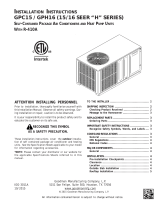
8
ELECTRICAL WIRING
General — Electrical power wiring must be made
in accordance with all applicable local codes and
ordinances, and with the current revision of the
National Electric Code NFPA 70 or in Canada
CSA C.22.1 - Canadian Electrical Code Part
1. If any of the original wire as supplied with
the unit must be replaced, it must be replaced
with material of the same gage and temperature
rating.
WARNING:
To avoid the risk of electrical shock,
personal injury, or death, disconnect
all electrical power to the unit before
performing any maintenance or service.
The unit may have more than one
electrical power supply.
Line Voltage — Before proceeding with the
electrical connections, make certain that the
voltage, frequency, and phase of the supply
source are the same as those specified on the unit
rating plate. Also verify that the service provided
by the utility is sufficient to handle the additional
load imposed by this equipment.
See the unit wiring label for proper high and low
voltage wiring. Make all electrical connections
in accordance with all applicable codes and
ordinances.
Use a separate branch electrical circuit for this
unit. A means of electrical disconnect must be
located within sight of and readily accessibility
to the unit. Internally mounted circuit breakers
are available as field installed options. These
circuit breakers can be used as an electrical
disconnect.
The unit is shipped from the factory wired for 240
volt transformer operation. For 208 volt operation,
remove the lead from the transformer terminal
marked 240V and connect it to the terminal
marked 208V. For maximum ampacity and over
current protection, see the unit rating plate.
Provide power supply (or supplies) for the unit in
accordance with the unit wiring diagram, and the
unit rating plate. Connect the line-voltage leads
to the corresponding terminals on the contactor
(or the circuit breaker when the field installed
circuit breaker kits are used) inside the control
compartment. Use only copper wire for the line
voltage power supply to this unit. Use proper code
agency listed conduit and a conduit connector
for connecting the supply wires to the unit and
for obtaining proper grounding. Grounding may
also be accomplished by using the grounding
lug provided in the control box.
WARNING:
The unit cabinet must have and
uninterrupted or unbroken electrical
ground to minimize personal injury if
an electrical fault should occur. This
ground may consist of electrical wire
or approved conduit when installed in
accordance with existing national or
local codes.
Blower Speed — The blower speed is preset
at the factory for operation at the same speed
for heating and cooling. For optimum system
performance and comfort, it may be necessary
to change the factory set speed. To change the
blower speed:
1. Disconnect all electrical power to the unit
and remove the service panel.
2. Remove the motor lead from terminal #4
of the blower relay. Cut the wire tie holding
the motor lead bundle. The motor leads
are color coded as shown in Figure 9.
3. If the desired heating blower speed is
different than the cooling speed, remove
and discard the jumper wire between
terminals #6 and #4. on the blower relay.
Place the desired heating blower speed
lead on terminal #6 and the desired cooling
blower speed lead on terminal #4 of the
blower relay. Use another wire tie (field
supplied) to bundle the remaining motor
leads.
CAUTION:
To avoid personal injury or property
damage, make certain that the motor
leads cannot come into contact with
any uninsulated metal components of
the unit.
Check all factory wiring per the unit wiring
diagram and inspect the factory wiring connec-
tions to be sure none loosened during shipping
or installation.




















